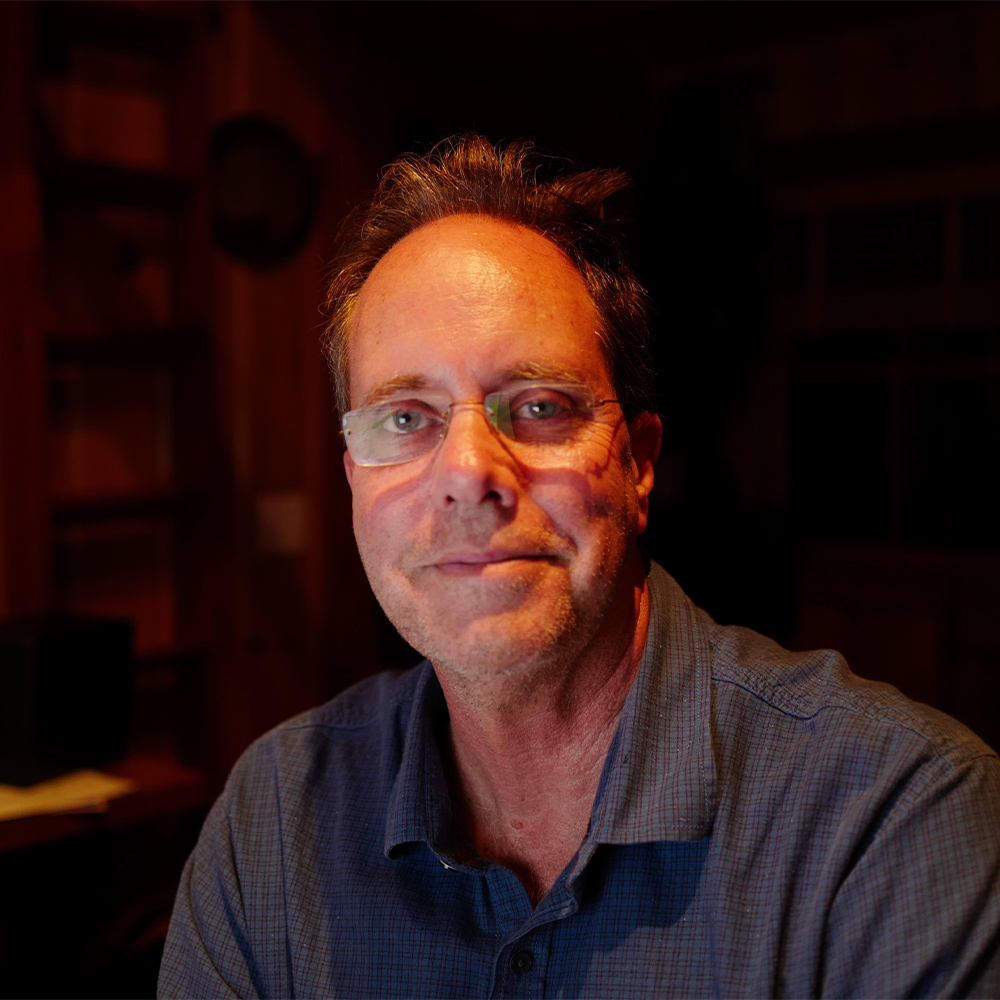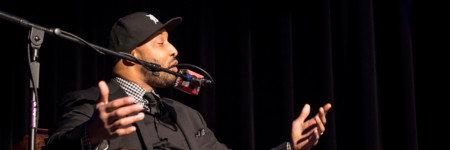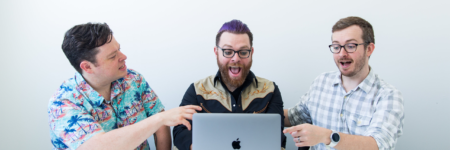Sometime back in the 80s or 90s, Jay Allison invented podcasting. His scheme was simple: there was a lot of really interesting radio airing at times he couldn’t listen, so he connected a VCR and microphone to his radio and recorded the shows he wanted to catch up on later. Allison surely wasn’t the only proto-podcaster recording radio on a timer for later listening, but the veteran producer carried it to the most extreme conclusion.
“I was dreaming of podcasting for a long time,” he says. “Like, on-demand listening to the full range of humanity. That, I thought, that is a dream. And lo and behold, it’s kind of come true.”

Allison doesn’t call himself a podcaster—the prolific independent producer stresses he is, above all, “a public media guy.” But podcast listeners know his work, whether it’s through The Moth Radio Hour, which he produces, or podcasts of shows from the Public Radio Exchange (PRX) that he helped found. Allison has helped found a lot of things, including Cape Cod public radio station WCAI, Atlantic Public Media, and public-media-education organization Transom. Thanks to Transom, Allison’s approach to public media has helped shape wave after wave of Transom Story Workshop students, many of whom have gone on to work on the biggest podcasts in the industry. Meanwhile, Transom’s podcast—which Allison hosted—spotlighted new work by up-and-coming producers emerging from the program.
In short, Allison is a veteran producer whose long career has not only bridged the glory years of terrestrial radio with the present “golden age” of podcasting, but has also helped define podcasting as we understand it in this moment of plentiful content. “For listeners who love listening,” he says, “the smorgasbord is insane.”
Allison likes the terrestrial centrality of radio, the way it broadcasts to a specific place, and how it can help listeners understand the place in greater detail by spotlighting local characters and voices. Yet by the last iteration of Transom’s Story Workshop, Allison asked the class how many students owned actual radios, and none did. “And they’ve just enrolled in a radio school!” He laughs. But he sees enormous value in the decentralized trade-off of podcasts, particularly when it comes to celebrating niche storytelling—which the broadness of broadcasting often stamped out.
“But voices on the edge, who are cast out a bit, are harder to get past gatekeepers—and that was always the struggle of public media.”
“Back in the early days of public radio, it was very hard to get weird stuff on the air,” Allison recalls, reflecting he was often reminded, “It’s broadcasting, not narrowcasting.” He wanted to expose listeners to unique and interesting audio with the hope it would “wake up their ears,” and that was a constant source of friction with management.
More than weird audio, Allison is enthusiastic about amplifying marginalized voices. “I want to hear those voices,” he says. “And I think public media claims it wants to put them out there. So I try to hold them to that. But voices on the edge, who are cast out a bit, are harder to get past gatekeepers—and that was always the struggle of public media.”
It should come as little surprise, then, that Allison is elated about how cheap and available audio equipment has become through the rise of podcasting. Old enough to recall lugging around a reel-to-reel recorder as cassette tapes were emerging, Allison has watched minidiscs, DAT, and finally smartphone technology forever alter the physical equipment of broadcast production.
“My studio occupied a whole room back then, and now it’s a laptop,” he says with enthusiasm. “So the technological barriers to entry are way down and everybody is an editor now. That’s an amazing change. Each one of those technological changes can open doors for more and more people. It used to be pretty rarefied—I mean, most people didn’t have their own TV or radio stations. And now they do.”
This is why Allison sees the present day as the golden age of podcasting—and in particular—of the kind of narrowcasting he used to get criticized for preferring.
“It’s a new era in terms of being able to find your people, to disintermediate, to cut past networks, and go straight to your listeners. It’s potentially a great thing for independence. All of that in podcasting is a great boon.”
Yet he notes that as the freedom of podcasting has emerged, some of the idealism of public radio seems to have burned up.
“The downside of podcasting is there’s no commons,” Allison says. “There’s no purpose that underlies it the way there is with public media—not that you always succeed! But at least there’s an idea that we care about public good, public service, educational value, all these things we put before profit.”
In the same way that public radio gatekeepers prevented some stories and subjects from getting airtime, limitations particular to podcasting present similar obstacles. Public media organizations worry about offending or upsetting their donors, but podcasts have to please the people holding the purse as well.
“The dynamics of podcasting require numerical counts and click measures, the cost per thousand, underwriting and all that,” says Allison, and the more intense these pressures become, the more the world of podcasting “becomes what public media isn’t, and that is just another marketplace.”
Allison is quick to acknowledge the problem with generalizations as big as these—about “the world of podcasting” or “public media”—is they’re each so big as to contain their own contradictions.
“You could make an argument that where public media has had a sense of purpose and too often failed, podcasting has succeeded on the commercial side,” Allison says, admitting those successes could shake one’s faith in the mission of public media. “Is the mission necessary,” he wonders, “if the structures, corporations, and non-profits all fail, but then a commercial structure arises and those [marginal] voices are unleashed? It’s an interesting paradox.”
Above all, Allison believes in the medium itself—of the power of recording voices and sounds and cutting them together to create a relationship between the listener and the creator. The experience of listening in all its forms is important to him. He compares the experience of listening to a public speaker in an audience, such as the live storytelling show The Moth, to the experience of listening to the podcast he produces from the live show:
“The Moth is a live performance thing to begin with,” he says. “And, you know, you would think [recording] it might dilute that experience of being with an audience—which it does. The audience experience is fundamental.”
Yet the experience of listening to the Moth on the radio or in a podcast is altogether separate from attending the show live, so different that podcast listening has separate merits.
“Because [on radio or podcast] the tellers are invisible, you can’t judge them before they start to talk, which everybody does—because the eyes are prejudicial,” he says. “You see what [a person’s] weight is, what their race is, what their gender is: your eyes make assumptions and judgment, but the ear can be fooled more easily. And so you have to reserve judgment for a while.” In particular, at a time when gender and ethnicity are at the heart of heated public debates, Allison is enthusiastic that audio listeners are limited in their ability to identify the ethnicity or gender of the storyteller “until well into it—or never.”
“Everyone talks about the intimacy of the spoken word, but it’s also completely detached from the human form.”
This is one of the things Allison celebrates as the “invisibility” of audio—if the audio is consumed as intended, then the people who made it are missing by design.
“Radio is fundamentally a disembodied experience, as is podcasting,” Allison says. “Everyone talks about the intimacy of the spoken word, but it’s also completely detached from the human form. So it’s an odd paradox that you have something so utterly intimate and so utterly detached which is also entrancing. I like playing at that boundary.”
For the storytellers Allison esteems the most—great characters with singular voices—that detachment is an ally. Allison wants to hear people on the radio who wouldn’t normally be heard; radio’s invisibility protects those voices from listeners prejudging them. Instead, listeners have to pay attention before they can make up their minds—and for Allison, that’s an opportunity to introduce voices often otherwise ignored or drowned out.
“I dedicate myself to that kind of person—to the scouts, the renegades, the outliers, the truth-tellers. I’m interested in the people who spend a whole year making one freaking thing that they can’t help but make. The excitement for me is keeping those voices alive in the podcasting context.”
Whether radio, streaming, or podcasting, Allison sees audio storytelling primarily as a humane bulwark against isolation.
“I just want to make sure there are contexts for those people,” he says. “A place [listeners] can feel they’re with their people and communicating with their people. Here at Transom, we ran a school that became a nexus.” That nexus, he says, operated as a beacon to other like-minded people, broadcasting one simple message above all: “Over here, this is where we care about this stuff. This is a place where you won’t feel lonely if you care about it too.”



Comments